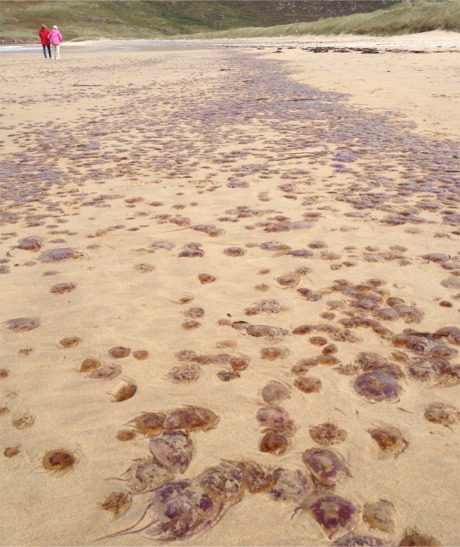|
|
Donegal under attack from
jellyfish invasion
18.09.13
DONEGAL fish farms are
on high alert due to an invasion by millions of
Atlantic jellyfish that wiped out €1.2m worth of
farmed salmon six years ago.
Marine biologists and the aquaculture industry are
closely monitoring the arrival of the 'Mauve
Stinger' or Pelagia noctiluca that have washed up in
astonishing numbers in western counties in recent
weeks.
Hundreds of thousands of the glow-in-the-dark
jellyfish have already been found beached from Kerry
to Donegal including the Inishowen and Rossguill
peninsulas.
On Rosses beach, near Melmore Head, Downings, last
week, stretches of sand were carpeted with hundreds
of thousands of jellyfish ranging in size from a
euro coin to over 15cm in diameter. Vast numbers of
jellyfish have also been stranded at Culdaff. |
 |
|
Some of the hundreds of thousands of
'Mauve Stinger' jellyfish that recently washed up at
Rosses Strand near Melmore Head, Downings. |
The Pelagia noctiluca
inflicts painful stings that can scar.
Jellyfish expert Dr Tom Doyle said fish farms were
aware of the danger and are trying to protect their
stocks from attack.
He said the jellyfish were less of a threat to wild
fish stocks which have the freedom to move out of
their path.
"The past couple of years have been very quiet in
relation to the 'Mauve Stinger' but they have been
particularly abundant this year and we have been
getting lots of sightings since August," said Dr
Doyle of the Coastal and Marine Research Centre in
Cobh, Co Cork.
He said the presence of them in enormous blooms had
previously closed Mediterranean beaches. He urged
late-season swimmers, surfers and beachgoers to
exercise caution and warned people not to touch any
jellyfish washed up on the beach.
"If you end up swimming through thousands of these,
you are going to get badly stung. And they can still
sting you if they washed up recently onto the beach
so they should not be touched," he added. He said it
was unclear why so many of the jellyfish are
becoming stranded adding that it is likely they are
simply "caught out" in a high tide or strong
current.
Fanad-based Marine Harvest Ireland said it was
closely monitoring jellyfish activity at its fish
farm sites along the western seaboard. The company
said it had noticed a significant increase in
jellyfish numbers in Irish waters in recent years.
“We are constantly looking at water samples for all
types of jellyfish which is part of our activities
especially in late summer, early autumn,” said
Marine Harvest Ireland managing director, Jan
Feenstra.
“When jellyfish numbers are high we feed the fish
less so that they are resting rather than active.
When they are not eating they have their gill covers
closed so they are less likely to be damaged by the
jellyfish.”
Some marine experts believe the increase in
jellyfish numbers globally is the result of
over-fishing of the predators that feed on
jellyfish.
A swarm of Pelagia noctiluca shocked the marine
world in November 2007 when it killed about 120,000
farmed salmon worth €1.2 million at Glenarm Bay, Co
Antrim.
It is understood the farmed fish died mainly from
stings to their gill tissue.
The Coastal and Marine Research Centre is currently
running The Big Jellyfish Hunt and is urging people
to get in touch with sightings and photos. Details
are on Facebook. |
|

